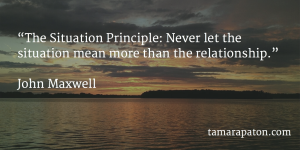

For many, the idea of meditation or mindfulness calls to mind images of incense and hippies. Chanting, namaste-ing, and focusing on one’s breath may appear relevant only to those who dabble in hallucinogenics.
There was a time in my career when I would have jumped to this stereotype. Meditation and the idea of inner work were foreign ideas to me. I was too busy seeking skills and status to slow down and look inside.
It might surprise you that this changed when I joined a global consulting firm known for slashing clients’ cost structures and redrawing org charts. In 2003, I learned to meditate alongside McKinsey & Company’s entire Canadian practice.
Each afternoon, a team room in the McKinsey Toronto office would become a sanctuary for mindfulness. Consultants would remove their shoes, sit comfortably, and follow a meditation teacher’s guidance. We slowed down and quieted the flurry of thoughts in our overworked brains. Refreshed, we would go back to reimagining industries.
Since then, mindfulness has been part of my personal leadership toolkit. Meditation helped me relax during childbirth (to the extent that’s even possible). And it’s been a core part of my marathon training. Very recently, it has helped me remain calm and professional in the wake of a tough career setback.
I’m not alone. Fortune 500 powerhouses, such as Aetna, GE and Nike, encourage employees to meditate. Google has a long waitlist for its Search Inside Yourself employee training program. NYU’s business school offers a Mindfulness in Business course. Even the Pentagon and the U.S. House of Representatives are in on the action (or the stillness, I suppose).
Individual leaders now talk openly about their experience with meditation. When author Tim Ferriss interviewed more than 200 executives for Tools of Titans, he found that 80% had some form of guided mindfulness practice. Former Microsoft CEO Steve Ballmer meditates, as do Bridgewater CEO Ray Dalio and Marc Benioff of Salesforce.com. One-time venture capital investor Jerry Colonna — known to some as the “CEO Whisperer” — now teaches executives how to meditate at week-long retreats.
And this isn’t a new thing. Barry Sommers, CEO of Wealth Management at J.P. Morgan Chase has avoided burnout by meditating twice daily for the past 10 years. Steve Jobs made use of mindfulness practice to challenge assumptions and enhance creative insight. And former Medtronic CEO Bill George began a daily meditation practice in the 1970s. His company built its first meditation room at headquarters in 1974.
Skeptics needn’t rely on anecdotal evidence and my encouragement. Decades of peer-reviewed research reveal the ways mindfulness can give leaders an edge. In my experience, these benefits align perfectly with the priorities of board directors.
Mindfully manage information
University of Virginia researcher Timothy Wilson argues that the human brain isn’t equipped to handle the 11-plus million bits of information arriving at any given moment. As a result, our minds have a tendency to wander 50% of the time. Fortunately, studies show that meditation training can help curb our tendency for distraction, strengthening our ability to stay focused and even boosting memory. This is good news for directors who are accustomed to receiving 300-page binders prior to each board meeting.
Don’t worry, be happy
When researchers from Harvard Medical School imaged the brain activity of those new to meditation, they found enhanced emotional regulation and perspective taking in the prefrontal cortex. Yi-Yuang Tang, a neuroscientist at Texas Tech, found that meditation boosted attention control and self-awareness. And Yale psychiatrist Judson Brewer observed that the pathways that fire amid unhappy thoughts deactivated during meditation.
Boost productivity
More than one-quarter of Aetna’s work force of 50,000 has participated in at least one meditation class. On average, they each report a 28 percent reduction in their stress levels and 62 minutes per week of newfound productivity. Aetna estimates is worth $3,000 per employee per year.
Be creative
In 2001, Marcus Raichle, MD, a neurologist at Washington University, used fMRI scans to look inside the brain during meditation. He found that even when it feels like our brains are “off,” a powerful system, the default-mode network, is running in the background. It’s this system— one that is “on” when we are “off”—that is often responsible for creative insight and breakthrough.
Improve self-awareness
Studies show that accurate self-assessment is a necessary condition for outstanding leadership. Without it, we struggle to build teams that add to our strengths and complement our weaknesses. The ability to assess yourself accurately can begin with your moment-to-moment experience of emotions, culminating in clearly knowing your capabilities and blindspots. One day, boards may meditate before considering their skills matrix.
Connect with others
Meditation increases our sense of connection to others and boosts compassion. A partner at McKinsey & Company credits meditation with his ability to observe more and react less. Given boards’ reliance on collaboration and influence, mindfulness could become a director’s secret weapon.
For these reasons, mindfulness is quietly becoming the new marathon for overachievers. Chade-Meng Tan, Google employee #107, likens it to physical fitness. “If you are a company leader who says employees should be encouraged to exercise, nobody looks at you funny,” Tan says. “The same thing is happening to meditation and mindfulness, because now that it’s become scientific, it has been demystified. It’s going to be seen as fitness for the mind.”
It’s easy to get started. If you tend to read email before your feet hit the floor each morning, notice how you feel when you start the day with 10 minutes of silence. Adding a meditation app to your phone’s home screen can offer a gentle reminder (check out Inscape, Headspace, or — my personal favourite — 10% Happier), Throughout the day, turning off notification alarms on your devices can further encourage a focus on the present.
Venture capital investor Jeffrey Walker recommends connecting with other leaders interested in mindfulness. “A small group of fellow travellers with whom you can have a ‘walls down’ relationship…will help you reinforce positive practices and will uncover areas you need to work on that you cannot see on your own.” You can also look around your workplace or attend a Wisdom 2.0 conference to build connections. At the very least, this social context will help your meditation practice feel more mainstream.
If you are like most executives and board directors, you spend a lot of time contemplating events that happened in the past, might happen in the future, or will never happen at all. We need tools that help us focus on what needs our attention and response right now.
Author, psychiatrist and Auschwitz survivor Viktor Frankl pointed us to a solution. “Between stimulus and response, there is a space. In that space is our power to choose our response. In our response, lies our growth and our freedom.”
Thank you for reading! If you found this post useful, please share it with others in your network. Doing so helps my work reach others and would mean so much to me.








